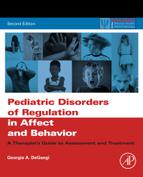Preface
How to use this book
Pediatric Disorders of Regulation in Affect and Behavior (Revised) is a skills-based book designed for use by mental health professionals and occupational therapists who work with children experiencing disorders of self-regulation. These are individuals who are intense, highly sensitive to stimulation from the environment, emotionally reactive, and have difficulty maintaining an organized and calm state of being. This book incorporates treatment strategies for children who struggle with everyday decisions, who may be impulsive in their actions, are easily frustrated, and react in extreme ways to everyday experiences. Some children with these problems crave intensity in interactions and in the environment. This may result in an overwrought and overstimulated state, a quick anger trigger, and day to day disorganization. In contrast, some children with these difficulties respond by withdrawing from the world or becoming avoidant or socially isolated. They may battle with depression and anxiety. Children with these struggles often have difficulty adapting to changing demands at home and school. They may be highly irritable, or respond in extreme or unpredictable ways. Their inconsistent response to caregivers, teachers, and friends in their life makes interpersonal relationships very challenging.
The symptoms often vary for children with disorders of self-regulation. These are individuals who have a combination of constitutional and emotional issues. Sometimes the child has a diagnosis that may include any of the following: bipolar or mood disorder, anxiety, depression, obsessive–compulsive disorder, Asperger’s syndrome, eating or sleep disorder, and/or attention deficit disorder. Frequently the child also has sensory integration problems that have never been diagnosed and treated. The interplay of symptomatology is discussed to help professionals integrate treatment strategies that address the individual’s regulatory, sensory integration, and mental health problems. Chapters in the book are organized to address the varying ways in which the problems manifest for children. One of the premises of this book is that the children may have a physiological predisposition that makes it extremely difficult for them to control their behavioral responses. Their nervous systems often do not give them accurate internal feedback to help them mediate their world.
Book format
The first chapter provides an overview of problems of self-regulation in children. It describes the different types of regulatory problems in children, emphasizing how these difficulties impact relationships with others, school performance, and everyday functioning. Two checklists appear at the end of this chapter, one to define the symptoms and type of regulatory disorder, the other to evaluate how the child interacts dynamically using a developmental framework. These two checklists should help guide the diagnostic and therapeutic process.
The chapters that follow focus on specific types of dysregulation. Each chapter includes background information that emphasizes the developmental and neurobiological underpinnings of the problem. Clinical observations and checklists appear at the end of each chapter that may be used for diagnosis and treatment planning to help the caregiver and child learn more about themselves and their problem. The treatment strategies described in each chapter integrate three main approaches from the fields of mental health and occupational therapy. These include dialectical behavioral therapy, mind–body therapies and sensory integration techniques, and interpersonal therapy. Dialectical behavioral approaches help the child to understand what his behavior means, to learn how to reframe problems in a more positive way, and to take charge of their problems in proactive ways. Since many individuals with regulatory difficulties have sensory integration problems and experience bodily reactions during interpersonal interactions and stressful life experiences, principles from sensory integration therapy and other mind–body techniques are described to help the child to self-calm and organize their body. Finally, emphasis is placed on the relational dynamics between the child and significant persons in his or her life including caregivers, friends, and others. Therapeutic techniques are provided on how to foster engagement with others in positive ways and to improve attachments while attending to the importance of providing physiological safety and reducing averse bodily responses that interfere with interactions with others. The importance of building resilience, developing support systems, and nurturing oneself within the context of a balanced, well-structured family life is discussed.
Each chapter presents detailed therapeutic strategies to help professionals to evaluate what might work in addressing common problems related to eating, sleep, mood regulation, anxiety, attention, and behavioral control. These treatment strategies are integrated into clinical case examples of children who experience specific problems of dysregulation. These clinical examples are based on actual cases but were changed to protect the identity of clients while preserving the clinical decision-making process and the dynamics of the therapeutic process. Many of these case examples incorporate how the child’s problems of dysregulation impact their relationships with others and their ability to function in everyday life. Cases were selected to reflect how treatment varies depending upon the age of the child with examples spanning from infancy through adolescence. Some of the cases are longitudinal and depict children’s treatment beginning in early childhood up through adolescence to reflect how symptoms evolve over time and how the interventions need to be modified accordingly.
Twenty skill sheets appear in the appendix of this book. These are intended to be used during the treatment process to help caregivers and children learn and apply the strategies described in this book. Each chapter references specific skill sheets that apply to the treatment approaches described for particular problems of dysregulation.
..................Content has been hidden....................
You can't read the all page of ebook, please click here login for view all page.
